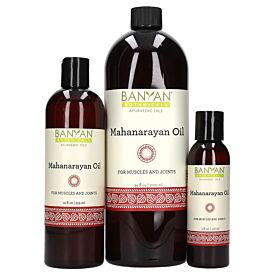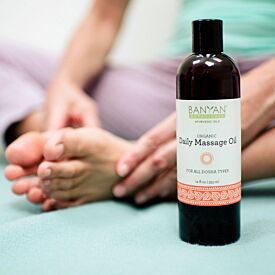10 Yoga Poses for Relaxation & Calming
Amidst the complexity of our modern culture and the many dynamic factors at play in our day-to-day lives, stress and anxiousness have become a commonplace experience—and in many cases a major culprit of dis-ease. Thankfully, the wisdom of Ayurveda offers endless tools to help reinstate balance in both mind and body.
The practice of yoga asana is one such tool, offering a powerful, effective, and systematic approach to shifting our internal state—physically, mentally, and emotionally.
The list of positive side effects that come from practicing yoga are practically endless—it can help with weight management, improve flexibility, support immune function, enhance mental clarity, and increase self-esteem, just to name a few. One of its main benefits, which we will focus on here, is its power to calm the nervous system and restore a sense of overall relaxation and peace.
Below you will find ten simple postures to support the parasympathetic nervous system—the oh-so-important rest and digest system—and create a sense of calm. Give them a try the next time you’re feeling overwhelmed, thrown off-kilter, or simply out of sorts!

Child's Pose (Balasana)
This resting posture can help release neck, shoulder, and back tension as well as calm the nervous system. Whenever you fold the body into itself, you instigate a cooling, relaxing, and grounding action. This can support you in drawing your energy inward and beginning to practice pratyahara, or the withdrawal of the senses.
Instructions:
Kneel on your yoga mat or a thick blanket and place your sit bones onto your heels. If this is uncomfortable for you, roll up another blanket and place it into the creases behind your knees.
Lower your torso towards the ground, either resting your chest on your thighs or spreading your knees out to the sides so that your belly can rest between your legs.
Place your forehead on the ground or onto a block (or stack of books!), then stretch your arms out in front of you or reach them back towards your feet. Make whatever adjustments you need to get as comfortable as possible.
Relax in this pose for up to five minutes, breathing deeply into your belly. If you notice that your thoughts wander and you start thinking about dinner or what happened at work, simply return your attention to your breath and give yourself space to relax.
Thunderbolt Pose (Vajrasana)
This posture can aid in stretching the thighs, knees, ankles, and feet, while also strengthening the back and core. It can help tone the pelvic floor, boost the digestive fire (agni), and even relieve indigestion. This is a wonderful pose for practicing seated meditation and breath work (pranayama).
Instructions:
Kneel on the floor, placing a folded blanket beneath your knees, shins, and feet. If needed, place a rolled blanket behind your knee pits to create more comfort.
Press the tops of your feet firmly and evenly into the ground and sit up tall. If there is discomfort, place a yoga block between your feet and sit on the block, rather than your heels. Work to keep your knees, shins, and feet directly in line.
Sitting tall, soften your shoulder blades gently down your back and reach the crown of your head towards the sky. Imagine widening through the chest and relaxing the shoulders down and away from your ears.
Rest your hands onto your thighs and gaze softly forward or close your eyes. Hold this posture for one to five minutes, keeping your attention turned inwards and inviting your breath to grow even and deep.
![]()
Easy Pose (Sukhasana)
This simple cross-legged sitting pose offers many positive benefits to the entire body, including strengthening the back and core, stretching the knees and ankles, and bringing relaxation to the mind. This pose, like Thunderbolt Pose, is a wonderful pose for seated meditation and pranayama.
Instructions:
In order to find a tall and comfortable seat, this pose is best done with support. Begin by grabbing a block or folding a thick blanket into a firm support, approximately six inches thick. Take a seat close to the edge of your block or blanket, sitting tall onto your sit bones.
Carefully bend your knees to come into a cross-legged position, making sure your knees and ankles are comfortable. If it feels difficult to sit up straight, boost yourself up even higher.
Find a neutral position for the pelvis and extend long through the spine, reaching the crown of your head towards the ceiling and softly engaging your core for support. Gently lift your heart and expand across your chest as you allow your shoulders to soften and relax.
Relax your hands onto your thighs, turning the palms face down for a more grounding quality or face up for a more receptive gesture. Close your eyes and deepen your breath. Enjoy this posture for one to five minutes or for the duration of your meditation or breath work practice.

Seated Forward Bend Pose (Paschimottanasana)
This forward bend helps stretch the hamstrings, lengthen the spine, and release the lower back, while simultaneously strengthening the core and quadriceps. As mentioned previously, folding the body forward also has a very calming and cooling quality on the nervous system.
Instructions:
Begin by sitting up straight with your legs stretched out in front of you. Keep your spine tall and your feet in dorsal flexion (toes coming back towards your shins and heels reaching forward).
Spread your toes and engage the muscles of your legs, gently rotating your inner thighs inwards and downwards towards the ground. If it’s difficult to sit up straight in this position, sit up onto a block or folded blanket and keep your knees slightly bent.
Take an inhale and reach your spine high towards the ceiling, then exhale and lean forward, bending at the hips to fold over your legs. Let go of the idea of getting your head to your knees. Instead, start to think more about lengthening and extending your heart towards your toes.
If you can easily reach your hands to your feet, you can grab your big toes and use the strength of your arms to help extend your spine. Otherwise, place your hands on the floor to either side of your legs, focusing on keeping the heart moving forwards and your neck long. The more you can activate your quadriceps, the more space you will find in your hamstrings.
With each breath, continue to lengthen your spine and find more space between each vertebra. Engage your core to stabilize your lower back, and gradually deepen the hinge of the hip joints. Rest into this posture for five to ten cycles of breath then carefully release, lifting the torso back up on an inhalation.
Wide-Legged Straddle Pose (Upavistha Konasana)
This is another forward-bending posture, excellent for bringing a sense of calm to the body and mind. It has the ability to stretch and strengthen both the inside and the backs of the legs while simultaneously opening and releasing the groin and hips.
Instructions:
Begin by sitting up tall with your legs stretched out wide in a 10 to 45 degree angle. Press your thighs firmly into the floor, point your kneecaps straight up at the ceiling, flex your feet, and spread your toes. Keep your leg muscles engaged as you slowly walk your hands forward between your legs.
As with all forward bends, the emphasis is on moving from the hip joints and maintaining the length of your spine, rather than rounding forward. As soon as you find yourself bending from the waist, pause and re-establish length. Back out of the pose slightly, lift up through your heart, and then continue forward if possible.
If your hamstrings are tight, your most beneficial posture may be seated tall with your chest and crown lifting towards the sky or folding forward just slightly. Practice contentment (santosha) wherever you are. Focus on how deeply you can breathe, not how close you can get to the floor! Stay in the pose one to three minutes and come up slowly on an inhalation.
![]()
Legs Up the Wall Pose (Viparita Karani)
This beloved restorative pose offers a plethora of benefits. To name a few—it is wonderful for circulating blood and lymph, relaxing the nervous system, supporting sound sleep, and relieving lower back pain, abdominal discomfort, stress, and feelings of anxiousness.
Instructions:
Sit next to a wall sideways with your knees bent and drawn closely into your chest. Slowly begin to rotate your body so that your back relaxes onto the floor and your legs extend up the wall (imagine your body in a 90-degree angle).
Take the time to play with various props and make any adjustments needed to be sure that your lower back is comfortable. For example, you can use a blanket or a bolster beneath the hips to create extra support and stabilization.
Once you are comfortable, do a scan of your body and invite each and every muscle to relax. Imagine your brain dropping towards the back of your skull, let your eyes soften towards the back of their sockets, and relax your jaw. Let your breath become slow and deep.
Rest in this posture anywhere from one to ten minutes. To release out of it, carefully bend your knees and bring them towards your chest, roll to one side, and use your arms to press yourself up.
Puppy Pose (Anahatasana)
This posture is wonderful for extending the spine, releasing tension in the upper back, and opening the shoulders. It can bring a spacious, relaxing quality to an overactive mind and a sense of opening and softening to the emotional heart.
Instructions:
Beginning on hands and knees, stack your shoulders over your wrists and your hips over your knees. Keeping your legs stationary, slowly walk your arms forward, stretching your spine until your chest is close (if not touching) your mat.
You can relax your forehead onto a block or onto your mat, being mindful not to create tension in the back of your neck. Stay here for five to ten breaths, allowing your heart to soften towards the earth while keeping your core engaged to prevent collapsing in the lower back.
To release, carefully walk your hands back and return to a neutral tabletop position.
Tree Pose (Vrksasana)
For many of us, feelings of stress and anxiousness can cause us to feel weak and unstable in both body and mind. Standing balancing postures like this one are a very tangible way to reconnect to your roots, find your stable center, and grow a feeling of power and strength.
Instructions:
Stand with your feet together and place your hands onto your hips. Ground your balance into your left foot and engage the muscles of your left leg, carefully floating your right foot off of the ground.
Mindfully place the bottom of your right foot either on the calf or upper thigh of your left leg, turning your knee out to the side as much as you can without shifting your hips. Be careful not to place your foot onto your knee.
Press your foot into your leg and your leg into your foot to bring your energy towards the centerline of your body. Root into your standing leg even as you lift up through your spine.
Once your balance is established, draw the hands together in front of your heart in prayer position. Keep a steady gaze in front of you, lift through the crown of your head, and breath evenly. Hold for five to ten breaths and then repeat on the other side.
Headstand (Sirsasana)
Changing perspective by literally turning your world upside down can be highly beneficial. Headstands increase agni, strengthen deep core muscles, support our ability to focus, establish balance, and help calm and steady the mind.
Instructions:
If you are new to this pose, start near a wall for support. Begin by coming onto hands and knees, stacking your shoulders over your wrists and your hips over your knees. Carefully lower your forearms to the ground, keeping your elbows shoulder-distance apart and interlacing your hands together to make a triangle with your arms.
Place the crown of your head onto the ground and cradle it in your hands. Tuck your toes and lift your hips high. Start walking your feet towards your head, getting as close to your elbows as possible. Engage your abdominal muscles and press your forearms into the mat, lifting out of your shoulders so that there is minimal pressure onto your head.
Until you feel steady, practice lifting just one leg at a time. If this feels stable and effortless, you can enter full headstand by lifting both legs straight up overhead. Use the wall for support if needed.
Hold for five to ten breaths, eventually working up to longer holds. To come out, lower your feet with control and rest in Child's Pose for a minimum of three breaths.

Savasana (Corpse Pose)
It seems like a no-brainer that this would make it onto the list as an important posture for relaxing the mind and nervous system. Savasana’s benefits are too numerous to name, but they include disengaging the sympathetic nervous system, decreasing blood pressure, softening stress and tension out of the muscles of the entire body, and helping the mind to become still.
Instructions:
Begin by lying flat on your back. Feel free to place a bolster or thick blanket beneath the knees or under the head if you’d like. Extend your arms and legs out at about a 45-degree angle, turning the hands palms face up and allowing the feet to relax. Relax the muscles of your entire body and bring your attention to your breath.
It’s a common misconception that the goal of this pose is to arrive at a place where your thoughts stop completely—but this isn’t a reality. Rather than trying to fight against the natural tendency of your mind—which is to think!—try to simply watch your thoughts pass through your mind without attaching to any particular one.
Practice becoming an observer of your mind. Every time you catch yourself wandering away into the land of the future or the past, return to the present moment by bringing your attention back to your breath. You can enjoy this pose anywhere from one to thirty minutes.
I hope these postures will help support a sense of stability, grounding, and peacefulness in your inner life, especially when things feel a bit chaotic all around you! It’s often the simplest practices that afford the most relief, bringing us back to center and reconnecting us to our hearts.








